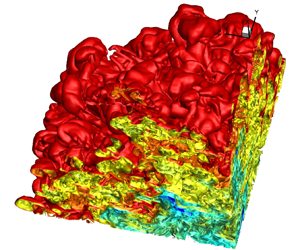Published online by Cambridge University Press: 04 October 2021

In this paper, the Richtmyer–Meshkov instabilities in spherical and cylindrical converging geometries with a Mach number of approximately 1.5 are investigated by using the high resolution implicit large eddy simulation method, and the influence of the geometric effect on the turbulent mixing is investigated. The heavy fluid is sulphur hexafluoride (SF6), and the light fluid is nitrogen (N2). The shock wave converges from the heavy fluid into the light fluid. The Atwood number is 0.678. The total structured and uniform Cartesian grid node number in the main computational domain is 20483. In addition, to avoid the influence of boundary reflection, a sufficiently long sponge layer with 50 non-uniform coarse grids is added for each non-periodic boundary. Present numerical simulations have high and nonlinear initial perturbation levels, which rapidly lead to turbulent mixing in the mixing layers. Firstly, some physical-variable mean profiles, including mass fraction, Taylor Reynolds number, turbulent kinetic energy, enstrophy and helicity, are provided. Second, the mixing characteristics in the spherical and cylindrical turbulent mixing layers are investigated, such as molecular mixing fraction, efficiency Atwood number, turbulent mass-flux velocity and density self-correlation. Then, Reynolds stress and anisotropy are also investigated. Finally, the radial velocity, velocity divergence and enstrophy in the spherical and cylindrical turbulent mixing layers are studied using the method of conditional statistical analysis. Present numerical results show that the geometric effect has a great influence on the converging Richtmyer–Meshkov instability mixing layers.